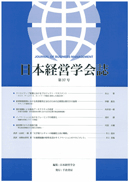Volume 31
Displaying 1-19 of 19 articles from this issue
- |<
- <
- 1
- >
- >|
-
Article type: Cover
2013 Volume 31 Pages Cover1-
Published: June 15, 2013
Released on J-STAGE: August 01, 2017
Download PDF (8668K) -
Article type: Appendix
2013 Volume 31 Pages App1-
Published: June 15, 2013
Released on J-STAGE: August 01, 2017
Download PDF (93K) -
Article type: Appendix
2013 Volume 31 Pages App2-
Published: June 15, 2013
Released on J-STAGE: August 01, 2017
Download PDF (93K) -
Article type: Index
2013 Volume 31 Pages 1-2
Published: June 15, 2013
Released on J-STAGE: August 01, 2017
Download PDF (54K) -
Article type: Article
2013 Volume 31 Pages 3-14
Published: June 15, 2013
Released on J-STAGE: August 01, 2017
Download PDF (1485K) -
Article type: Article
2013 Volume 31 Pages 15-26
Published: June 15, 2013
Released on J-STAGE: August 01, 2017
Download PDF (1517K) -
Article type: Article
2013 Volume 31 Pages 27-38
Published: June 15, 2013
Released on J-STAGE: August 01, 2017
Download PDF (1459K) -
Article type: Article
2013 Volume 31 Pages 39-49
Published: June 15, 2013
Released on J-STAGE: August 01, 2017
Download PDF (1627K) -
Article type: Article
2013 Volume 31 Pages 50-62
Published: June 15, 2013
Released on J-STAGE: August 01, 2017
Download PDF (1596K) -
Article type: Article
2013 Volume 31 Pages 63-74
Published: June 15, 2013
Released on J-STAGE: August 01, 2017
Download PDF (1563K) -
Article type: Article
2013 Volume 31 Pages 75-80
Published: June 15, 2013
Released on J-STAGE: August 01, 2017
Download PDF (849K) -
Article type: Bibliography
2013 Volume 31 Pages 81-84
Published: June 15, 2013
Released on J-STAGE: August 01, 2017
Download PDF (261K) -
Article type: Appendix
2013 Volume 31 Pages 85-
Published: June 15, 2013
Released on J-STAGE: August 01, 2017
Download PDF (85K) -
Article type: Appendix
2013 Volume 31 Pages 85-
Published: June 15, 2013
Released on J-STAGE: August 01, 2017
Download PDF (85K) -
Article type: Appendix
2013 Volume 31 Pages 86-
Published: June 15, 2013
Released on J-STAGE: August 01, 2017
Download PDF (56K) -
Article type: Appendix
2013 Volume 31 Pages 87-88
Published: June 15, 2013
Released on J-STAGE: August 01, 2017
Download PDF (97K) -
Article type: Appendix
2013 Volume 31 Pages 89-
Published: June 15, 2013
Released on J-STAGE: August 01, 2017
Download PDF (127K) -
Article type: Appendix
2013 Volume 31 Pages 90-
Published: June 15, 2013
Released on J-STAGE: August 01, 2017
Download PDF (37K) -
Article type: Cover
2013 Volume 31 Pages Cover2-
Published: June 15, 2013
Released on J-STAGE: August 01, 2017
Download PDF (24K)
- |<
- <
- 1
- >
- >|
